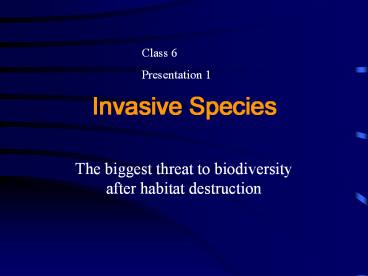Invasive Species - PowerPoint PPT Presentation
1 / 24
Title:
Invasive Species
Description:
Class 6 Presentation 1 Invasive Species The biggest threat to biodiversity after habitat destruction Overview Impact Examples Summary of characteristics of invasive ... – PowerPoint PPT presentation
Number of Views:196
Avg rating:3.0/5.0
Title: Invasive Species
1
Invasive Species
Class 6 Presentation 1
- The biggest threat to biodiversity after habitat
destruction
2
Overview
- Impact
- Examples
- Summary of characteristics of invasive
3
Definition
- Organisms (usually transported by humans) which
successfully establish themselves in, and then
overcome, otherwise intact, pre-existing native
ecosystems (World Conservation Union (IUCN)).
4
Impact
- Economic impact billions of dollars/year (See
next slide) - Impacts on biodiversity
- Research/Regulation/Control/Management
- 30,000 non-native spp in N Am since colonization
- 30 of 4,200 vascular plant spp in Canada exotic
(not all invasive)
5
African land snail (Achatina fulica) in Florida
- 3 snails smuggled in by boy returning from Hawaii
in 1966 - Grandmother released them in her garden
- Problem noticed in 1969
- Mailed info to 150,000 houses
- Infestations found 25 km outside initial area
- Eradication program started, 18k snails found
- Cost US 1 million
6
Alien agricultural and forest pests in Canada
2002 Report of the Commissioner of the
Environment and Sustainable Development
7
How do they get around?
- Aquatic ballast tanks in ships (simple solution
to eliminate problem exchange water at sea) - Non-deliberate most linked to human activity
- Deliberate
- soil erosion prevention kudzu
- Feel like home birds and game fish
- Some related to agriculture, ornamentals,
captivity (e.g. aquarium trade).
8
Beech Bark Disease (Nectria coccinea var.
faginata)
9
Dandelion
10
Gypsy Moth (Lymantria dispar)
11
Dutch elm disease (Ophiostoma ulmi)
12
Life History Characteristics of Invasive Species
- Plants
- Reproduce sexually and asexually
- Self fertilization
- Lack of seed pre-treatment for germination
- Long period seed on plant
13
Can we detect invasiveness?
- Early attempts to look for life traits of a
species that would link that spp with potential
invasiveness have failed. Why? - Best bet is to study those that have become
invasive high probability for being invasive in
another similar ecosystem
14
Life History Characteristics of Invasive Species
- Exotic spp often have fewer infections and
predators. - Drop in all diseases amoung European plants in N
Am 77 - Ave of parasites in home range 16
- Ave parasites in new range 3
D. Pimental et al, Nature, Feb 6, 2003
15
Life History Characteristics of Agricultural
Invasive Plants
- Herbaceous
- Rapid reproduction
- Dispersed abiotically
16
Life History Characteristics of Natural Area
Invasive Plants
- Aquatic or semi-aquatic
- Grasses
- Climbers
- Nitrogen fixers
- Clonal trees
17
Life History Characteristics of Invasive Birds
- Dispersal ability
- High rate of population increase
- Large clutch size
- Several clutches/season
- Compete with native species
18
Life History Characteristics of Non-Invasive
Organisms
- Lack of pre-adaptation to new environment
- Competition/Predation from native organisms
- Diseases
19
Life History Characteristics of Invasive Fresh
Water Fish
- Tolerance to broad range of environments
- Rapid dispersal
- Aggressive behaviour
- Short generation time
20
Other features
- Desired by humans
- Close association to human activity
21
Summary
- Early germinators (gap grabbers)
- Competitors for resources
- Reallocate resources to growth/reproduction
- Survivors (resist death)
- Swampers (mass germinators)
22
Genetics and Evolution
- Good source of research on genetics and evolution
- Rapid directional selection
- Hybridization (interspecific or previously
isolated populations)
23
Genetics and Colonization
- Pre-adaptation important
- Adaptive evolution also important
- Rate of change to natural selection proportional
to amount of additive genetic variation present - Multiple introductions genetic diversity ?
24
Range Expansion
- Rapid expansion large amount of gene flow
- May constrain local adaptation































